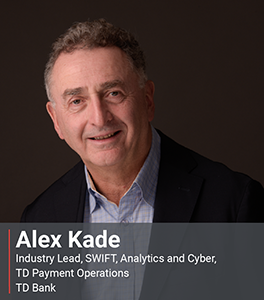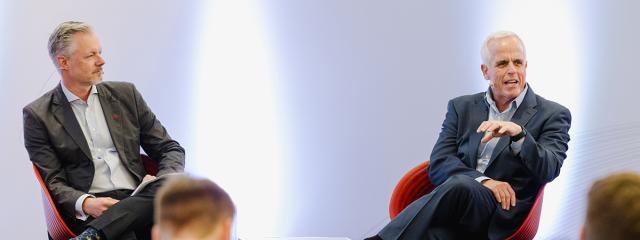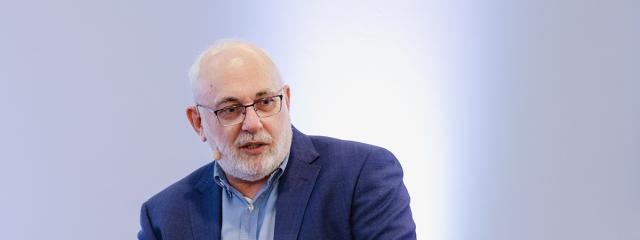Bringing ISO 20022 to high-value payments in Canada: A TD perspective
Alex Kade, Industry Lead, SWIFT, Analytics and Cyber, TD Payment Operations at TD Bank shares how he and his team are working with Payments Canada and the broader payment ecosystem to bring Lynx Release Two to life in late 2022. Alex also talks about his role as co-chair of the Lynx MX Management Committee, the group responsible for providing leadership and oversight to support the design and delivery of Lynx Release Two.
How is TD preparing for the second release of Lynx?
We are overhauling our wire payment technology platform to support the new ISO 20022 financial messaging standard being introduced globally by SWIFT and supported domestically by Lynx. We will evolve to a fully ISO 20022-based system capability over a period of time in line with the SWIFT MT/MX coexistence strategy.
TD is taking a holistic approach, focused not just on renewal of our wire payment platform, but also on the evolution of channels and initiation points for high-value and cross-border payments across the bank. We believe that the full potential of the enriched data format will only be realized by enabling our upstream and downstream business capabilities with ISO 20022. It will allow us to leverage the new data, reduce friction points and create more value-add services for our customers.
What does the introduction of ISO 20022 to the Lynx system mean to your organization?
ISO 20022 is the globally accepted standard for creating enriched payment and non-payment messages. It will enable more efficient payment clearing and settlement among financial institutions (FIs) through the use of a common set of messages and agreement on their usage.
Furthermore, it will enable interoperability between different financial market infrastructures (FMIs). It is truly a key component for making payments faster and more efficient in the future. Essentially, ISO 20022 will create a common language and model for payment data across the organization and the industry - one that provides higher quality data and therefore higher quality payments and ultimately, a better customer experience. This will also allow participants and systems across different financial markets (e.g. payments, securities, foreign exchange) to communicate using consistent terminology and syntax.
How is the introduction of ISO 20022 to the Lynx system helping to set the foundation for payment innovation to take place in Canada over the coming years?
The initial launch of Lynx in 2021, included new technology (application and infrastructure) and a new risk model that is in line with global standards for FMIs. This has provided us with a modern and robust platform for innovation going forward.
Lynx Release Two introduces the use of the ISO 20022 format to support Canadian domestic and related cross-border wire payments with standardized and enriched data flows. The result of all these efforts is the emergence of an environment where we can start to integrate the various payment channels (e.g. wires, bulk payments, real-time payments) to create a seamless payment experience for customers across borders and traditional channels.
It's about creating a payment ecosystem with greater transparency, near real-time fulfillment, ease-of-use, cross-border convenience and one that is forward looking to emerging open banking solutions.
What are some of the benefits that you see for TD, in being able to send and receive ISO-enabled payments at the launch of release two?
We see a number of important benefits to being able to send and receive ISO 20022-enabled payments:
- Interoperability between the domestic payment scheme and global market infrastructures, as well as integration of cross-border payments with local instant payment schemes.
- Enhanced remittance information supported within the payment message will enable greater straight-through-processing (STP) for commercial customers and ease-of-use, as well as new services for retail customers.
- Expanded and structured data will support improved regulatory compliance and more efficient reconciliation processes.
What value do you feel the Lynx MX Management Committee brings to the delivery of Lynx Release Two? What has been the most rewarding part of being co-chair?
The Lynx MX Management Committee brings people from all of the Lynx participant organizations together to work through questions of scope, industry rules, deployment approach and to manage overall program risks. It has been a great forum for consultation and collaboration.
In my role as co-chair, representing the FI participant’s concerns, my focus has been on building consensus on issues like the domestic ISO 20022 roll-out timeframe and bringing to the table issues related to the parallel roll-out of SWIFT's new Transaction Manager platform which will have both operational and regulatory impacts on how we process payments with cross-border and domestic legs.
The most rewarding part of this experience has been the camaraderie shown by individuals who represent different organizations that are normally competitors. In this case, we have a common interest and goal in seeing Lynx Release Two rolled out successfully.
In your role at TD, you have witnessed a great deal of change in payments. What are you most excited about for the future of payments?
I think we all agree that payments need to be faster, cheaper and more convenient. The legacy architecture built over the last 30 years is incredibly complex and I think that new technologies should allow us to dramatically simplify this and thus enable new products and services at an accelerated pace.
In particular, the exploratory work around central bank digital currencies (CBDC) is important as this will further transform the payment landscape - promoting financial inclusion, operational efficiency and adding another level of payment resiliency. With respect to our global reach, can we improve on the inherent inefficiencies of the traditional correspondent banking model to move money across borders? Possibly a system of connected CBDCs would allow us to do just that.




